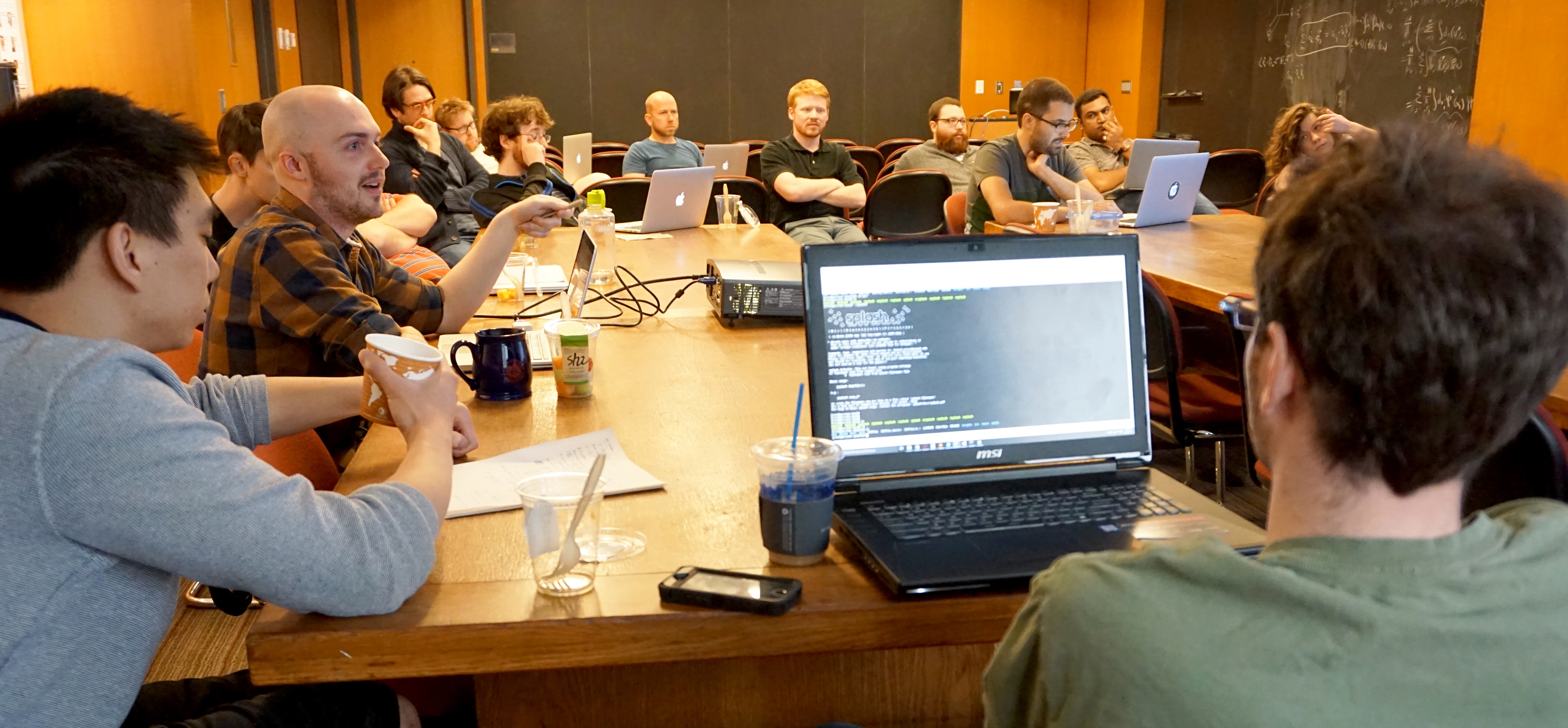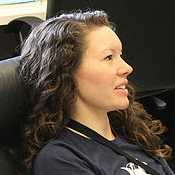Theory Group Meetings 2017-2018
Theory Group Meetings are held at 12:00 PM in Tech F160 (2145 Sheridan Rd) unless otherwise noted Theory Group Meeting is the informal weekly discussion group of theoretical astrophysicists at CIERA. Discussions usually center around blackboard talks given by graduate students and postdocs at Northwestern, but can include prepared talks given external speakers, as well. Whatever slides or material the speaker brings in, Theory Group Meeting often becomes a quite detailed discussion of the fundamental theoretical astrophysics topic being addressed. Also, while topics under discussion often relate to theory, observational astrophysicists are definitely welcome!

Spring Quarter 2018
| Date |
Speaker / Seminar |
| Apr. 20 |
|
| |
|
| Apr. 27 |
Jeremy Rath
Understanding Multi-Planet System Chaos through Resonant Dynamics
|
|
| |
Adam Dempsey
Creating the chaotic GJ876 Laplace resonance with smooth migration
|
|
| May 4 |
Katie Breivik
Can we really discover black holes with Gaia?
|
|
| |
Alex Gurvich
Firefly: a portable web-based 3d data visualization tool
|
|
| May 11 |
|
| |
|
| May 18 |
|
| |
|
| May 25 |
|
| |
|
| June 1 |
|
Winter Quarter 2018
| Date |
Speaker / Seminar |
| Jan. 19 |
|
| |
|
| Jan. 26 |
Kyle Kremer
Compact Binaries in Globular Clusters
|
|
| |
|
| Feb. 2 |
Howard Chen
Simulating 3-D Biosignature Gases from Earth-like Planets in the James Webb Era
|
|
| |
|
| Feb. 9 |
 |
Jose Oñorbe
Caltech
What do we know about HI Reionization? New Constraints from the High-z Lyman-α Forest
|
|
| |
 |
Kate Alexander
Harvard University
Radio Observations of Tidal Disruption Events
|
|
| Feb. 16 |
 |
Pranab Ghosh
TIFR
Super-Chandra Masses of Type Ia Supernova Progenitors
|
|
|
 |
Andrea Antoni
University of California - Santa Cruz
The Evolution of Binaries in a Gaseous Medium: Three-Dimensional Simulations of Binary
Bondi-Hoyle-Lyttleton Accretion
|
|
| Feb. 23 |
Cliff Johnson
Measuring Star Formation Efficiency and Molecular Cloud Evolution in the Small Magellanic Cloud
|
|
|
Pablo Marchant
Pulsational Pair-instability Supernovae in Very Close Binaries
|
|
| Mar. 2 |
|
|
Sasha Tchekhovskoy
When Pulsars Get Hungry
|
|
| Mar. 9 |
 |
Amy Reines
Montana State University
Informal Discussion
|
|
| |
Ben Nelson
Quantifying the Evidence for an Exoplanet in Radial Velocity Data
|
|
Fall Quarter 2017
| Date |
Speaker / Seminar |
Sep. 22
*11:00am |
 |
Suzanne Aigrain
University of Oxford
Taming the Stochastic: How Gaussian Processes are Transforming Exoplanet Studies
Almost all of the staggering progress in detecting and characterizing extra-solar planetary systems over the past 20 years or so has relied on time-series data. The planetary signals are typically buried in complex, correlated noise, such as stellar variability or instrumental systematics, which the "traditional" statistical toolbox of most astronomers was ill equipped to deal with. Over the past few years, Gaussian process (GP) regression has become increasingly popular as a means of modelling these "nuisance signals" explicitly, within a Bayesian framework, so that the resulting uncertainties can be propagated through to the final exoplanet parameters.
I will give a brief historical overview of how this has come about, drawing from my own experience with transmission and eclipse spectra of hot exoplanets, and radial velocity searches for planets around active stars. I will highlight the importance of having a fully specified generative model for one's data set, which can be used for simulations as well as regression, and reflect on the new possibilities which are opening up thanks to the increasing availability of highly scalable GP regression tools. Finally, I will discuss some new ways in which GPs are likely to impact the field of exoplanets even further in the future, including GP classifiers for automated vetting of transiting planet candidates, and Bayesian quadrature to model radial velocity and/or astrometry observations of stars hosting an unknown number of planets. |
|
| Sep. 29 |
 |
Phil Cowperthwaite
Harvard University
Deep Rapid Optical Follow-Up of Gravitational Wave Sources with the Dark Energy Camera
|
|
| |
 |
Chelsea Harris
UC Berkeley
Modeling Supernova Interaction with Circumstellar Material
|
|
| Oct. 6 |
 |
Paz Beniamini
George Washington University
Formation of Double Neutron Stars and Implications for Heavy Element Production
|
|
| |
|
| Oct. 13
|
 |
Matthew Liska
University of Amsterdam
GPU-based GRMHD Simulations of Tilted Black Hole Accretion Disks and Jets
|
|
| Oct. 20
|
 |
Kristen Garofali
University of Washington
Using High-Mass X-ray Binaries to Probe Massive Binary Evolution
High-mass X-ray binaries (HMXBs) provide an exciting window into the underlying processes of both binary as well as massive star evolution. Because HMXBs are systems containing a compact object accreting from a high-mass star at close orbital separations they are also likely progenitors of gamma-ray bursts and gravitational wave sources. I will present work on the classification and age measurements of HMXBs in M33 using a combination of deep Chandra X-ray imaging, and archival Hubble Space Telescope data. I am able to constrain the ages of the HMXB candidates by fitting the color-magnitude diagrams of the surrounding stars, which yield the star formation histories of the surrounding region. Unlike the age distributions measured for HMXB populations in the Magellenic Clouds, the age distribution for the HMXB population in M33 contains a number of extremely young (<5 Myr) sources, including M33 X-7, an eclipsing binary composed of a ~15 Msun black hole accreting from a 70 Msun O star companion. I will discuss these new results for M33 in the context of the effect of host galaxy properties on the observed HMXB population. |
|
| |
 |
Michael Tremmel
Yale University
Dancing to ChaNGa: The Formation of Supermassive Black Hole Pairs in Cosmological Simulations
I present the first self-consistent prediction for the distribution of formation timescales for close Supermassive Black Hole (SMBH) pairs following galaxy mergers. Using Romulus25, the first large-scale cosmological simulation to accurately track the orbital evolution of SMBHs within their host galaxies down to sub-kpc scales (Tremmel+ 2015, 2017), we predict that it is relatively rare for galaxy mergers to result in the formation of close SMBH pairs with sub-kpc separation and those that do form are often the result of Gyrs of orbital evolution following the galaxy merger. The likelihood and timescale to form a close SMBH pair depends on the mass and morphology of the accreted satellite galaxy, with the timescale becoming short when SMBHs remain embedded within a stellar core that is able to avoid tidal disruption. Otherwise SMBHs are deposited at large radii without any stellar core to aid in their orbital decay, resulting in a long lived population of wandering SMBHs. I discuss the implications of this long lived, galaxy-scale orbital decay on predictions for SMBH merger rates and examine the population of wandering SMBHs within Milky Way-mass galaxies predicted by our simulations. |
|
| Oct. 27
|
 |
Aleksey Generozov
Columbia University
Formation of X-ray binaries in the Galactic Center via tidal capture
|
|
| |
Chris Pankow
Using Gravitational Waves to Predict the Kilonova Properties of GW170817
|
|
| Nov. 3 |
|
| Nov. 17 |
 |
Dan Stevens
Ohio State University
Precision Stellar and Planetary Astrophysics with TESS and Gaia
There is an ever-present need for empirically measured, precise and accurate stellar parameters -- specifically, masses and radii. This is illustrated by two recent examples: the debate over the true masses of "retired A stars," and the significant discrepancies between modeled and observed M dwarf radii and temperatures. The latter issue is exacerbated by the fact that only a handful of M dwarfs -- all from double-lined eclipsing binaries (EBs) -- have both masses and radii measured to 3% or better. In the Gaia era, we can now measure model-independent masses and radii for single-lined EBs and expand the sample of stars with precisely measured parameters by at least an order of magnitude, in principle. I will illustrate how we are combining Gaia parallaxes, broad-band stellar fluxes, eclipses, and radial velocities to determine nearly model-independent masses and radii of single-lined eclipsing binaries. I will present our estimates of the expected achievable constraints, using a couple F+M binaries and KELT-11, a subgiant host of a sub-Saturn planet, as examples. I will discuss plans to use TESS to characterize dozens of bright single-lined EBs known from the KELT and HAT transit surveys, along with those that will be additionally discovered by TESS. Finally, I will preview how, by leveraging complementary data such as stellar surface gravities and densities from flicker and astroseismic analyses of TESS photometry, detailed abundances from ground-based surveys, and six phase-space coordinates from Gaia, we can produce a treasure trove for precision stellar astrophysics, comparative exoplanetology, and Galactic archaeology. |
|
For more information, contact:
ciera@northwestern.edu
Past Theory Group Meetings
|


















